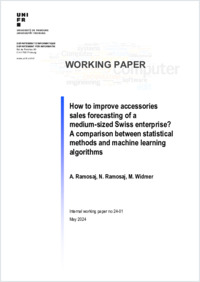How to improve accessories sales forecasting of a medium-sized Swiss enterprise? A comparison between statistical methods and machine learning algorithms
BP2-STS
- Ramosaj, Agneta ORCID University of Fribourg
- Ramosaj, Nicolas School of Engineering and Architecture of Fribourg, HES-SO University of Applied Sciences and Arts, Western Switzerland
- Widmer, Marino ORCID University of Fribourg
- 2024
26 p.
Demand forecast
Key account manager (KAM)
Seasonal autoregressive integrated moving average (SARIMA)
Machine learning (ML)
K-nearest neighbors (k- NN)
Least absolute shrinkage and selection operator (LASSO)
Linear regression
Random forest (RF)
Root mean square error (RMSE)
Mean absolute error (MAE)
English
Forecast accuracy is a crucial topic for industrial companies, and its impacts are particularly important for the finance and production departments. The company can incur high costs if forecasts are not accurate, for example, due to stock-outs or excess inventory.
Therefore, the purpose of this study was to optimize accessories forecasting for a medium-sized Swiss enterprise. To do so, different forecasting techniques were tested, and statistical methods and machine learning (ML) algorithms were compared. The results were adjusted according to key account managers’ (KAM) expertise.
This paper presents a comparison between exponential smoothing, seasonal autoregressive integrated moving average (SARIMA), SARIMAX (SARIMA with exogenous variables) and ML algorithms, such as k-nearest neighbors (k-NN), least absolute shrinkage and selection operator (LASSO) regression, linear regression, and even random forest (RF).
To compare these different methods, two measures of statistical dispersion are computed: mean absolute error (MAE) and root mean squared error (RMSE). The results are standardized to enable a better comparison. For our dataset, SARIMAX (with the KAMs’ expertise as an exogenous variable) appears to give better results than all the ML algorithms tested.
Therefore, the purpose of this study was to optimize accessories forecasting for a medium-sized Swiss enterprise. To do so, different forecasting techniques were tested, and statistical methods and machine learning (ML) algorithms were compared. The results were adjusted according to key account managers’ (KAM) expertise.
This paper presents a comparison between exponential smoothing, seasonal autoregressive integrated moving average (SARIMA), SARIMAX (SARIMA with exogenous variables) and ML algorithms, such as k-nearest neighbors (k-NN), least absolute shrinkage and selection operator (LASSO) regression, linear regression, and even random forest (RF).
To compare these different methods, two measures of statistical dispersion are computed: mean absolute error (MAE) and root mean squared error (RMSE). The results are standardized to enable a better comparison. For our dataset, SARIMAX (with the KAMs’ expertise as an exogenous variable) appears to give better results than all the ML algorithms tested.
- Collections
- Faculty
- Faculté des sciences et de médecine
- Department
- Département d'informatique
- Language
-
- English
- Classification
- Computer science and technology
- Series statement
-
- Internal working papers DIUF ; 24-01
- License
- License undefined
- Persistent URL
- https://folia.unifr.ch/unifr/documents/328639
Statistics
Document views: 79
File downloads:
- IWP24_01_diuf.pdf: 229
